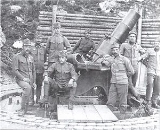
24 cm Mörser M 98
Encyclopedia
The 24 cm Mörser M 98 was a heavy siege howitzer used by Austria-Hungary
during World War I
. It was designed to attack modern fortifications, but its short range and ineffective ammunition lead to the development of the more deservedly famous 30.5 cm Mörser M 11 and M 16.
It was notable as the first weapon with a modern recoil system to see service with the Austro-Hungarian artillery as well as the first design to require motor traction. It was broken down into four loads for this purpose. Its carriage was mounted on a static firing platform that was jacked up and down onto its prepared bedding. It could only be loaded at 0° elevation.
against the Pretoria forts but were not needed, reportedly they fired one round at Boers attacking a picquet outside Pretoria. They were later sent to China during the Boxer Rebellion
but were also not used in action there.
In UK use they fired a 280 lb (127 kg) common pointed shell up to 7,650 yards, using 5 lb 8¼ oz cordite MDT propellant.
They were returned to UK from China and each of the two siege companies each fired 100 rounds from them but they had not been regarded seriously. However, they were issued to the new third siege company and used for annual practice where numerous defects became clear. Minor modifications were made but the critical defect, no elevation below 42 degrees, giving a high trajectory, made accurate fire impossible with the methods of the time. In addition, replacing the ballistite cartidges with cordite reduced the maximum range by 1000 yards.
Austria-Hungary
Austria-Hungary , more formally known as the Kingdoms and Lands Represented in the Imperial Council and the Lands of the Holy Hungarian Crown of Saint Stephen, was a constitutional monarchic union between the crowns of the Austrian Empire and the Kingdom of Hungary in...
during World War I
World War I
World War I , which was predominantly called the World War or the Great War from its occurrence until 1939, and the First World War or World War I thereafter, was a major war centred in Europe that began on 28 July 1914 and lasted until 11 November 1918...
. It was designed to attack modern fortifications, but its short range and ineffective ammunition lead to the development of the more deservedly famous 30.5 cm Mörser M 11 and M 16.
History
Based on a Krupp 1888–1890 design Skoda developed a new heavy mortar on a middle pivot mounting for testing in 1896. However the authorities realsed that advancing technology required a newr design, this used a barrel in a cradle mounted on a hydraulic recoil system. While introduced in November 1900, it wasn't quite ready and went through a number of minor improvements. One major problem was weak recoil springs that would allow the barrel to slip out of its cradle while elevated. Leather and horsehair stoppers could be wedged in the cradle as a short-term fix. But the permanent fix had to wait until the M 98/7 version that extended the jacket surrounding the barrel to the muzzle and redesigned the cradle was produced after 1907.It was notable as the first weapon with a modern recoil system to see service with the Austro-Hungarian artillery as well as the first design to require motor traction. It was broken down into four loads for this purpose. Its carriage was mounted on a static firing platform that was jacked up and down onto its prepared bedding. It could only be loaded at 0° elevation.
BL 9.45 inch Howitzer in United Kingdom service
The UK bought 4 guns held in stock by Skoda in Pilsen in February 1900 and designated the gun Ordnance BL 9.45 inch Howitzer Mk I. The purchase action by Sir Henry Brackenbury served two purposes, to thwart a German agent acting on behalf of the Boers and to provide a capability for use against the forts around Pretoria. They were sent to South Africa for use in the Second Boer WarSecond Boer War
The Second Boer War was fought from 11 October 1899 until 31 May 1902 between the British Empire and the Afrikaans-speaking Dutch settlers of two independent Boer republics, the South African Republic and the Orange Free State...
against the Pretoria forts but were not needed, reportedly they fired one round at Boers attacking a picquet outside Pretoria. They were later sent to China during the Boxer Rebellion
Boxer Rebellion
The Boxer Rebellion, also called the Boxer Uprising by some historians or the Righteous Harmony Society Movement in northern China, was a proto-nationalist movement by the "Righteous Harmony Society" , or "Righteous Fists of Harmony" or "Society of Righteous and Harmonious Fists" , in China between...
but were also not used in action there.
In UK use they fired a 280 lb (127 kg) common pointed shell up to 7,650 yards, using 5 lb 8¼ oz cordite MDT propellant.
They were returned to UK from China and each of the two siege companies each fired 100 rounds from them but they had not been regarded seriously. However, they were issued to the new third siege company and used for annual practice where numerous defects became clear. Minor modifications were made but the critical defect, no elevation below 42 degrees, giving a high trajectory, made accurate fire impossible with the methods of the time. In addition, replacing the ballistite cartidges with cordite reduced the maximum range by 1000 yards.

